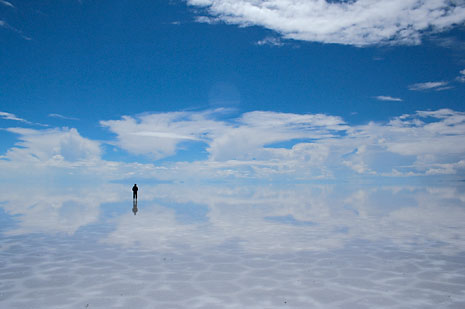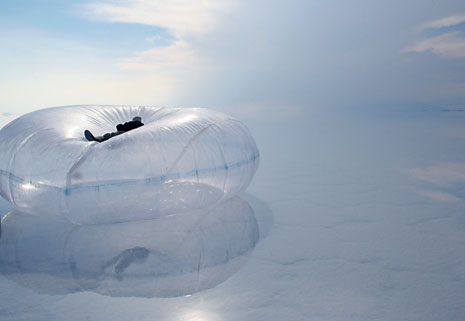 [Image: Tomas Saraceno, via Domus].
[Image: Tomas Saraceno, via Domus]."A sun is rising behind a large glass surface among the trees," Daniel Birnbaum writes in Domus, and that sun's "bright light is reflected in the water. Huge balloons hover in the air, some transparent, others lit from within. Hundreds of people gather on the small green island at night. What kind of strange place is this?"
 [Image: Tomas Saraceno, via Domus].
[Image: Tomas Saraceno, via Domus].This "strange place" is actually "a small island in a river running through a large European city." Specifically, if somewhat disappointingly, it's an art institute called "the new Portikus," and it's located in Frankfurt, Germany.
As it happens, the new Portikus is in the midst of a long run of art installations, and so the sun we just saw "rising behind a large glass surface among the trees" is really a project designed by Olafur Eliasson’s Light Lab. The project is "visible at night from across the city," and is part of what Birnbaum calls "a solar lab."
After all, he adds, all of the artworks in this series "will all relate to the notion of heliotropism."
 [Image: Tomas Saraceno, via Domus].
[Image: Tomas Saraceno, via Domus].However, artist Tomas Saraceno, also exhibiting at Portikus, is "more interested," we read, in how people could start "living in the skies."
Saraceno thus "explores the possibilities of air-borne housing as a conceivable solution to the problems of population growth and rapidly changing climates."
Elsewhere, in an interview with Stefano Boeri and Hans Ulrich Obrist, Saraceno says: "Up in the sky there will be this cloud, a habitable platform that floats in the air, changing form and merging with other platforms just as clouds do. It will fly through the atmosphere pushed by the winds, both local and global... in a permanent state of transformation, similar to nomadic cities."
In other words, it'll be a bit like the Helicopter Archipelago...
In the same interview, Saraceno then describes another project called the Flying Garden. The Flying Garden will be an "invasion" of the sky, "made up of plants, humans and animals."
For instance, "there will be 'air plants'," he says, taken "from the genus Tillandsia. Native to South America and Africa, these are true air plants: they derive all their nutrition from the air, imbibing rain and dew and whatever nutrients the air brings to them through their leaf tissues. There are no roots for water and nutrient uptake so they are quite air-sufficient."
This actually reminds me of an image I've had in my head for several years now: which is a forest, growing at its own faunal pace, over years, decades, even centuries, yet all the plants are rooted in transparent soil – clear hillsides like plastic or glass – so you can actually sit there in the sun, reading Charles Darwin, everyday, every week, watching those slow and ancient roots push deeper and deeper into the earth.
Worms crawl, as if through space, forming tunnels – underground landscapes of air. After the sun goes down, you walk out into the middle of the woods with a flashlight and you shine it straight down through the surface of the earth, illuminating tangles of roots and buried streams.
No comments:
Post a Comment